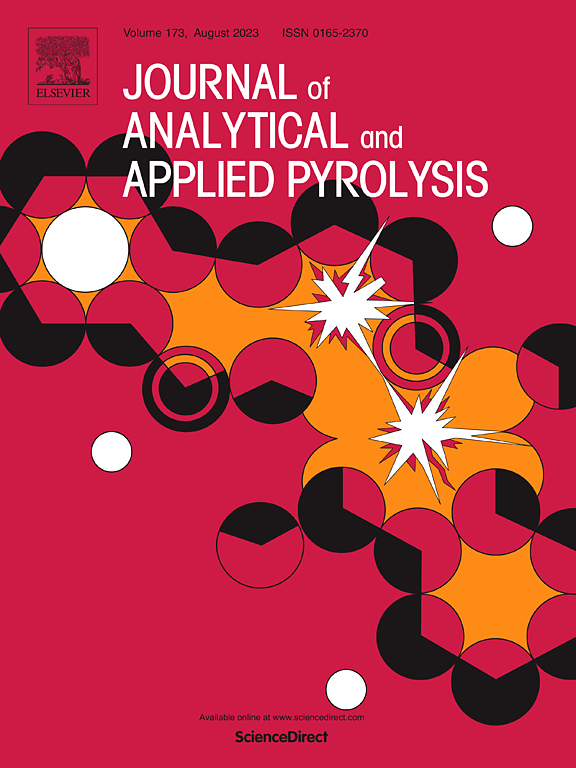Hydrothermal liquefaction of Spanish crude olive pomace for biofuel and biochar production
IF 5.8
2区 化学
Q1 CHEMISTRY, ANALYTICAL
引用次数: 0
Abstract
The olive oil industry is an important source of agricultural residues throughout its value chain, ranging from intermediate process slurries to relatively dry content pruning residues. Among them, crude olive pomace (COP) is of particular interest since it is abundant, low cost and can be a promising source for bioenergy. Nevertheless, because COP is phytotoxic and has a high moisture content and low energy density, it represents a challenge to conventional processes that usually require a dry and homogenous material. The main novelty of this study is the use of a transition metal catalyst and a central composite design (CCD) approach to optimize the conversion of COP through hydrothermal liquefaction (HTL) into valuable products. Results show that catalytic HTL is capable of converting up to half of the COP into bio-oil. Higher process temperatures resulted in lower bio-oil yields but larger higher heating value (HHV) and lower N content. The bio-oils produced at higher temperatures also show lower concentration of phenols and regarding biochar, a low inorganic content. Without any further upgrading, COP bio-oils produced by HTL are rich in valuable compounds such as oleic acid, phenolic compounds and ketones that can be used in the polymer industry or as chemical intermediates. The highest bio-oil yield was 51.96 wt% at 330 ºC for 30 min and 7.5 wt% catalyst with a HHV of 22.0 MJ/kg. At those operational conditions, the biochar yield was 16.49 wt% with a HHV of 8.9 MJ/kg. The major minerals found in the biochars (CaO, SiO2 and P2O5) suggests that biochar could be well-suited for use in soil applications or as materials for adsorption, especially the non-catalytic ones. Furthermore, the experimental results acquired from HTL of COP were used to develop a global kinetic model. Using an explicit Runge-Kutta method, the kinetic parameters were calculated. After comparing the global kinetic model with a linear system of ordinary differential equations (ODEs) based on the CCD models, results indicate that this approach is more effective in predicting the yields of HTL products.
橄榄油产业是整个价值链中农业残留物的重要来源,从中间加工过程的泥浆到相对干燥的修剪残留物。其中,粗橄榄渣(COP)尤其引人关注,因为它资源丰富、成本低廉,是一种很有前景的生物能源。然而,由于 COP 具有植物毒性,而且水分含量高、能量密度低,这对通常需要干燥、均匀材料的传统工艺来说是一个挑战。本研究的主要创新点是使用过渡金属催化剂和中心复合设计(CCD)方法,通过水热液化(HTL)优化 COP 向有价值产品的转化。结果表明,催化 HTL 能够将多达一半的 COP 转化为生物油。工艺温度越高,生物油产量越低,但热值(HHV)越高,氮含量越低。在较高温度下生产的生物油还显示出较低的酚类物质浓度,就生物炭而言,无机物含量较低。在不进行任何进一步升级的情况下,高温催化燃烧产生的 COP 生物油富含有价值的化合物,如油酸、酚类化合物和酮,可用于聚合物工业或用作化学中间体。在 330 ºC 30 分钟和 7.5 wt% 催化剂条件下,生物油产量最高,达到 51.96 wt%,HHV 为 22.0 MJ/kg。在这些操作条件下,生物炭产量为 16.49 wt%,HHV 为 8.9 MJ/kg。在生物炭中发现的主要矿物质(CaO、SiO2 和 P2O5)表明,生物炭非常适合用于土壤应用或作为吸附材料,尤其是非催化材料。此外,从 COP HTL 中获得的实验结果被用于开发一个全局动力学模型。使用显式 Runge-Kutta 方法计算了动力学参数。在将全局动力学模型与基于 CCD 模型的线性常微分方程(ODE)系统进行比较后,结果表明这种方法在预测 HTL 产物的产量方面更为有效。
本文章由计算机程序翻译,如有差异,请以英文原文为准。
求助全文
约1分钟内获得全文
求助全文
来源期刊
CiteScore
9.10
自引率
11.70%
发文量
340
审稿时长
44 days
期刊介绍:
The Journal of Analytical and Applied Pyrolysis (JAAP) is devoted to the publication of papers dealing with innovative applications of pyrolysis processes, the characterization of products related to pyrolysis reactions, and investigations of reaction mechanism. To be considered by JAAP, a manuscript should present significant progress in these topics. The novelty must be satisfactorily argued in the cover letter. A manuscript with a cover letter to the editor not addressing the novelty is likely to be rejected without review.

 求助内容:
求助内容: 应助结果提醒方式:
应助结果提醒方式:


